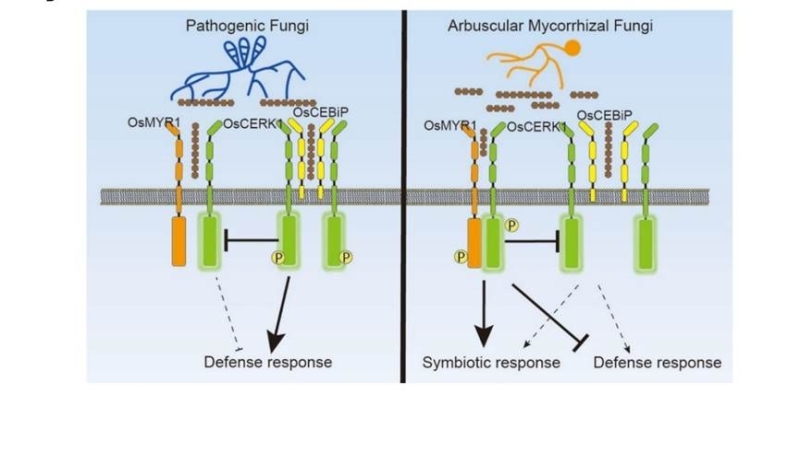Discerning Symbiosis and Immune Signals in Plant
Plants live and interact with diverse microbes in nature, including symbionts and pathogens. To discern friends from foes, plants have evolved various receptors that sense external microbes. In April 2021, Center for excellence and innovation in molecular plant science, Chinese Academy of Sciences, published a research paper entitled "Distinguishing symbiosis and immunity signals by receptor competition in rice". This study reveals a molecular mechanism of plant recognizing and discerning pathogenic and symbiotic fungi, and provides a new perspective for comprehensively understanding the immunosuppression in the process of symbiosis between plants and arbuscular mycorrhizal (AM) fungi.
AM fungi secrete short-chain chitooligosaccharides (COs) and non-sulphated lipochitooligosaccharides (LCOs), called mycorrhizal factors (Myc factors), that are recognized by plant receptors and mediate the establishment of AM symbiosis. In rice, AM symbiotic signal is precepted by a lysin-motif (LysM)-containing receptor kinase (LYK), OsMYR1, that directly binds to CO4 and subsequently interacts with OsCERK1 (Zhang et al., 2015; He et al., 2019 from the same group). Interestingly, OsCERK1 is also a well-known receptor involved in PAMP (pathogen-associated molecular pattern)-triggered immunity (PTI), which interacts with OsCEBiP to recognize chitin and trigger immune responses. Thus, OsCERK1 is a node crossing immunity and symbiosis. How these opposing signals are discerned via OsCERK1 remains unknown.
Zhang Chi, He Jiangman and colleagues in Wang Ertao’s lab found that receptor competition enables the discrimination of symbiosis and immunity signals in rice. On the one hand, the symbiotic receptor OsMYR1 and Myc factor CO4, inhibit the complex formation between OsCERK1 and OsCEBiP, and suppress OsCERK1 phosphorylating the downstream substrate OsGEF1, which reduces the sensitivity of rice to PAMPs. Indeed, OsMYR1 overexpression lines are more susceptible to fungal pathogen Magnaporthe oryzae, whereas Osmyr1 mutants show higher resistance. On the other hand, OsCEBiP binds OsCERK1 and thus blocks OsMYR1-OsCERK1 heteromer formation. Consistently, the Oscebip mutant displayed a higher level of AM colonization at early stages. These results indicate that OsMYR1 and OsCEBiP competing for OsCERK1 determines the outcome of symbiosis and immunity signals.
The research was supported by the National Science Foundation, (32088102, 31730103, 31825003 to E. W.), the National Key R&D Program of China (2019YFA0904703, 2016YFA0500502), the Ministry of Agriculture of China for Transgenic Research (2016ZX08009-003-001, 2016ZX08009003005-003) and the Strategic Priority Research Program ‘Molecular Mechanism of Plant Growth and Development’ of the Chinese Academy of Sciences (XDB27040207).
Article link: https://www.pnas.org/content/118/16/e2023738118
Contact:
Dr. Ertao Wang
National Key Laboratory of Plant Molecular Genetics, CAS Center for Excellence in Molecular Plant Sciences (CEMPS), Chinese Academic of Sciences
Email: etwang@cemps.ac.cn

An SPDT (Single Pole Double Throw) switch model in symbiosis and defence signaling pathways. When plants recognize CO8 from fungal pathogen, OsCEBiP will bind OsCERK1 with the help of CO8. This complex formation will inhibit OsMYR1 binding OsCERK1 to activate defence signaling. When plants recognize CO4 from symbiotic fungi, OsMYR1 will bind OsCERK1 with the help of CO4, and inhibit OsCEBiP binding OsCERK1. This complex will activate symbiosis signaling and inhibit defence signaling. OsCERK1 acts as a common receptor that can activate distinct signaling pathways when bound to different co-receptors.